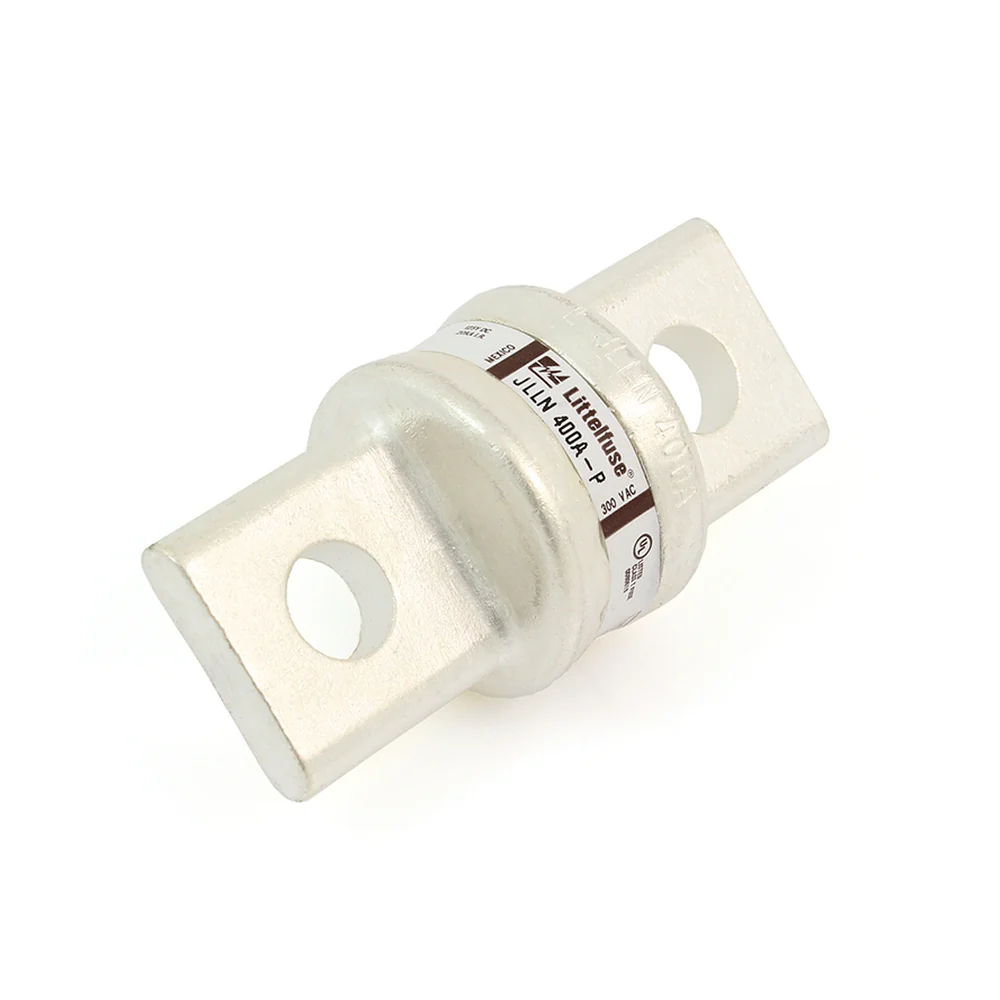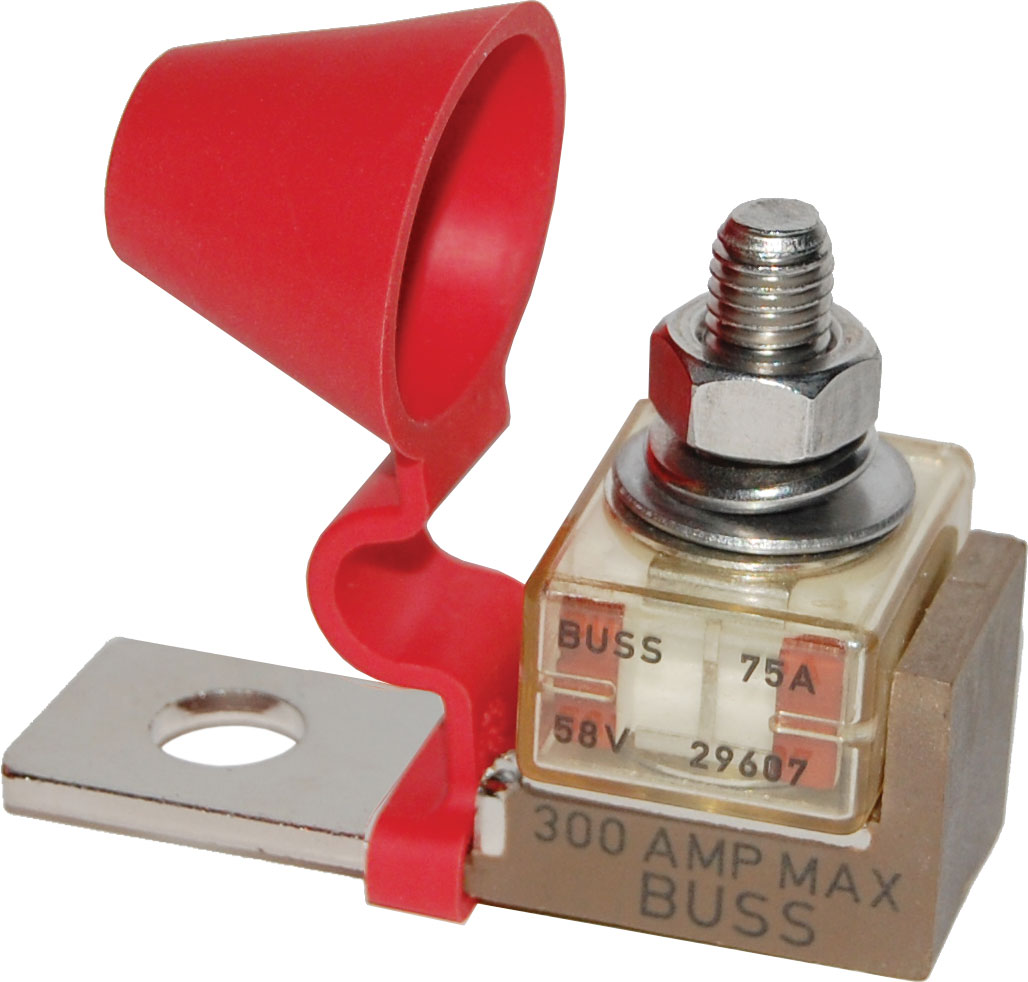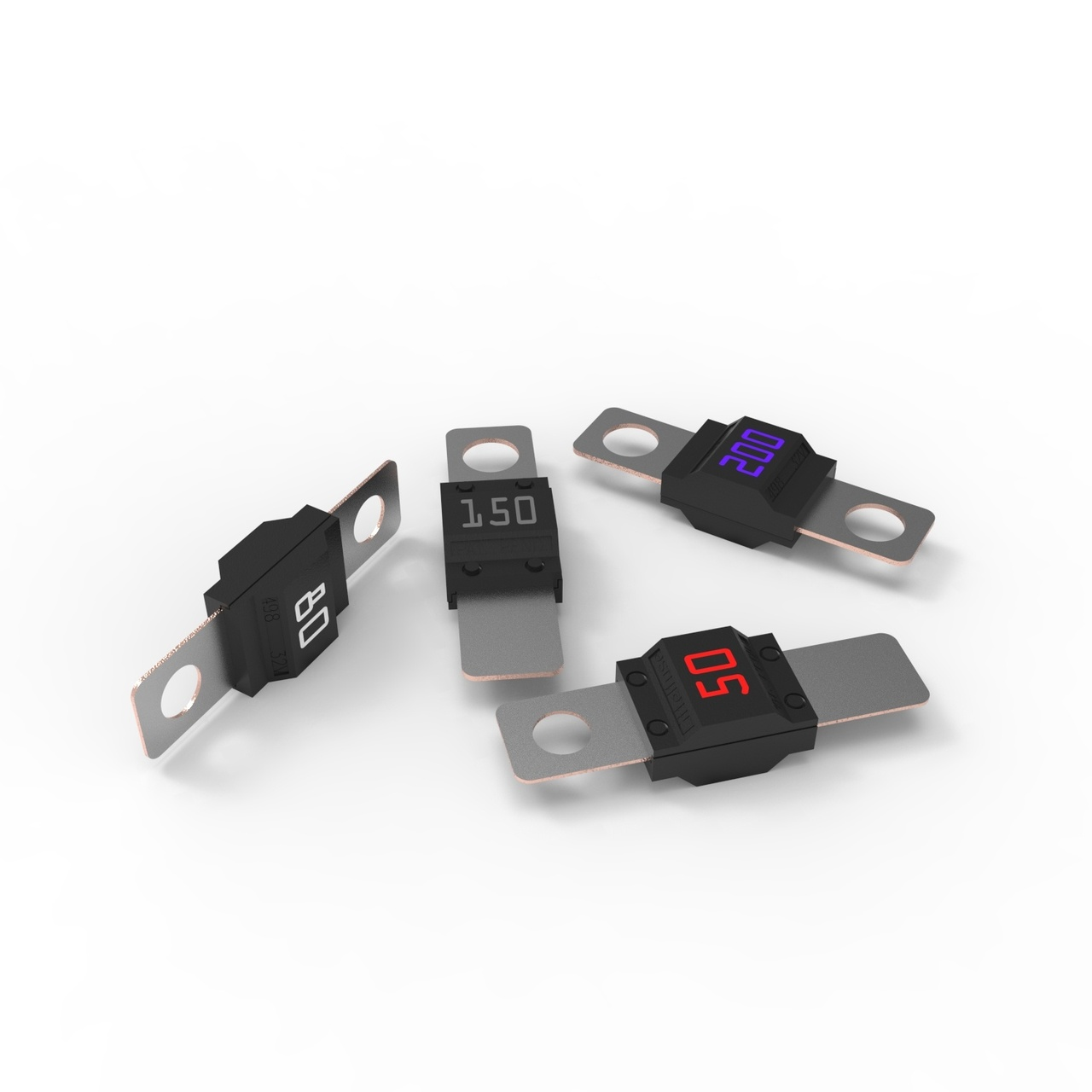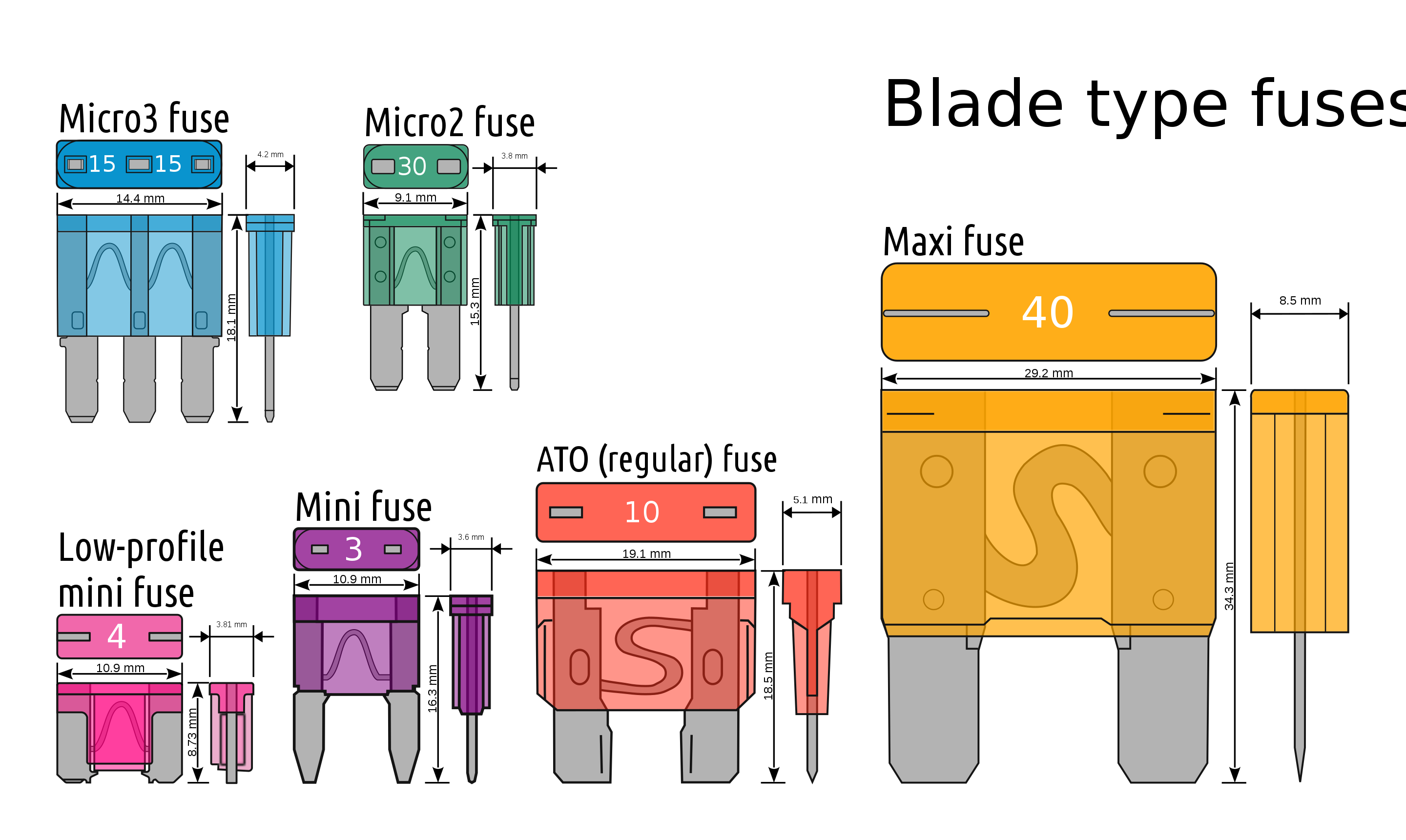Battery protection fuses for LiFePO4
There are many different types of DC fuses and it's important that you choose the appropriate fuse type for each application. In this article we are only focusing on the main battery protection fuse, between your battery and the rest of your system.
Please note that while Roamer's Battery Management System (BMS) provides both over-current and short circuit protection for your system, this is not a replacement for an appropriate battery protection fuse. Also note that products and regulation may vary by country and application so if you are unsure, please speak to a professional installer or other competent person before attempting to install your battery.
Understanding fuse characteristics
The characteristics of a battery protection fuse that we are most interested in are it's Ampere rating, Time current curve, Voltage rating and Ampere Interrupt Current (AIC).
Ampere rating
This is the number printed on the fuse which tells you how much current the fuse can safely pass continuously without tripping. The battery protection fuse is there to protect the main battery cable so you should choose a fuse with Ampere rating higher than the maximum possible current of your system and less than the current rating of the cable. It is NOT determined by the battery BMS continuous current rating (this is a characteristic of the BMS not your system).
Time current curve
Slower acting fuses are capable of carrying a lot more than their Ampere rating over short time periods without blowing. So for example, if a fuse with Ampere rating of 100A is exposed to currents of 120A, it may take several minutes to trip but if a current of 300A is applied then it will trip much quicker. The battery protection fuse needs to allow for short term peak loads especially if you are running an inverter (which can usually draw up to 2x the continuous power rating for 10 seconds).
Voltage rating
If you are using a higher voltage battery system (48V or more) then you will also need to consider the voltage rating of the fuse. Most commercial DC fuses are rated for up to 32V (making them appropriate for 12V and 24V systems) whereas a 48V battery bank will require a fuse that is rated for up to 58V.
Ampere Interrupt Capacity
This refers to the maximum fault current that the fuse is able to interrupt under test conditions. If a short circuit current above this current level is applied then there is a danger that the contacts could weld together and the fuse would not break the circuit. This is less relevant on a lead acid battery because of the relatively high internal resistance of the cells but a good quality LiFePO4 battery will have very low resistance and the short circuit current could exceed 3000A from a single battery.
Recommended fuse types for lithium LiFePO4 batteries
Class-T
Class T fuses are the gold standard for use with LiFePO4 batteries and are recommended for all Roamer 48V batteries as well as large 12V and 24V banks made up of multiple linked batteries. Class-T fuses usually rated for voltages up to 125V (and some are 300V or higher), they come in a range of Ampere rating sizes up to 1200A and have an AIC rating of 20,000A. This means you're covered for pretty much any application involving lithium battery banks. The downsides are the upfront costs (a Class-T fuse and fuse holder can exceed £100) and the difficulty with installing close to the battery terminals, something that is specified in marine regulations.
You can purchase Genuine Blue Sea / Littelfuse / BEP Class-T fuses and holders from Roamer here
MRBF (Marine Rated Battery Fuse)
If Class-T is the gold standard, then MRBF is the half-step down to something a bit more sensibly priced for systems with a lower short circuit current potential. They can be used for all system voltages up to 58V and come in a range of Ampere rating sizes from 30A to 300A. MRBF have an interrupt rating of 10kA at 12V (reducing to 5kA at 24V and 2.5kA at 48V) which makes them suitable for 12V (and smaller 24V systems) but you may want to consider Class-T fuses for larger systems involving 48V batteries or systems that require a higher AIC rating.
MRBF fuses are certified for marine use as a main battery protection fuse as they're waterproof and demonstrate sufficient protection for most lithium battery systems. Another key benefit to an MRBF is the convenient busbar fuse holder which allows you to mount to the battery terminal, providing protection as physically close to the battery cells as possible. While still fairly expensive, they are more affordable than Class-T and the convenience and simplicity of installation make them a big favourite of ours when designing 12V and 24V electrical systems.
Do not confuse MRBF with CF fuses. These look very similar and are cheaper but do not have the same characteristics, specifically they have a much lower interrupt current rating. A lot of sellers will market these as MRBF or terminal fuses but they are NOT the same.
You can purchase genuine Eaton MRBF fuses and holders from Roamer here
Recommended fuses for loads and chargers
MEGA fuses
MEGA fuses are perfect for loads and chargers as they come in a range of Ampere ratings from 60A to 500A, they are common and easy to source due to their use in vehicles and they are relatively cheap. They are not suitable for use as the main battery protection fuse with a LiFePO4 lithium battery however. With an AIC of just 2000A, they may not be able to interrupt the short circuit current of a Roamer LiFePO4 lithium battery which could result in a catastrophic failure in the event of a fault.
Most MEGA fuses have a voltage rating up to 32V. For 48V systems however, you will need to find the 60V rated version which are a lot less common and more expensive (£30 per fuse compared to £3).
We recommend using MEGA fuses for all main loads, chargers and inverters when cable sizes are 16mm2 or more (as the smallest fuse rating is 60A). A Victron Lynx Distributor (or modified Lynx Power IN) is perfect as a fuse holder and busbar system to use with MEGA fuses and we normally specify this setup in our electrical system designs.
MIDI
The same sentiments apply from the MEGA to the MIDI fuse, they are simply a smaller physical size - often fuse choice will be dictated by the fuse holder or posts available.
A general rule is that anything below 60A would be a MIDI fuse, as MEGA fuses only go as low as 60A. MIDI fuses range from 30-200A ratings. MIDI fuses will require a MIDI fuse holder, either a single inline holder or a combi fuse holder box. MIDI fuses and fuse holders are relatively cheap and therefore ideal for low power or compact systems.
ANL
A good alternative to MEGA/MIDI fuses, although they are not interchangeable. These are suitable for some loads, but devices such as inverters may cause issues with their high surge currents when first connected. For this reason, the slower blowing MEGA fuse is recommended.
Maxi/ATO/ATC/ATM/Micro/Micro2 etc...
These are the fuses you're probably more familiar with. They are the types of fuse that are in your car/van and we've all had to replace one at some point. They're cheap and easy to replace and have a fairly wide range of Ampere ratings (1A to 40A). Plenty for small devices but not suitable for use with inverters or high power chargers.
Fuses vs circuit breakers
Whilst circuit breakers are very useful solution in certain applications it should be noted that a good quality fuse will normally be more reliable (there are no moving parts) and should be considered first. If using a circuit breaker, make sure you buy a high quality model from a recognised brand - these will often be significantly more expensive than those found on online marketplaces but will be more reliable and are tested to recognised safety standards.
Which fuse do I use?
In most systems, you'll be using a few different types, and multiple different ratings too. Fuses are always specified on the capacity of the cables or battery cells in the circuit they protect; this is why we can't just give you a "use this fuse" answer; as it truly does depend on multiple factors.
Roamer's Electrical Design Service is one way to get the right values, calculated by professionals. All of our schematics come with the correct fuse ratings on the diagram and the correct type of fuse in each instance.
Contact us on support@roamer.com if you have any questions.






